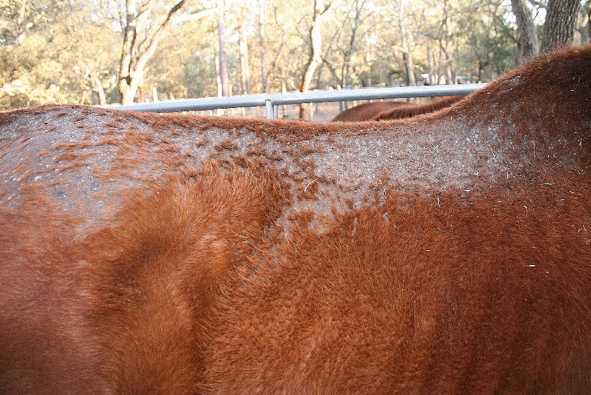Due to the ridiculous amount of rain the South-west (and everywhere else) has been experiencing of late, skin conditions such as ‘Dermo’ are common at the moment. Read here a bit about it, as it is a good one to avoid!
The condition of dermatophilosis, or “Rain scald” is caused primarily by a bacterium called Dermatophilus congolensis, an opportunistic pathogen and common commensal inhabitant of the skin. It is not found as a free-living agent in the environment. Prolonged wetting of the hair is usually involved.
Secondary infection with other skin bacteria is common and the highest incidence of this condition occurs in prolonged winters or in wet summers. Some horses may be more prone to the disorder than others suggesting that a genetic susceptibility may exist. Immunocompromised and malnourished horses are far more susceptible but serious infections can occur in almost any horse. Immunity is short-lived so recurrent infections may occur.
Clinical Signs
Early lesions appear as a mildly painful, non-itchy exudative (pus) dermatitis. The lesion begins as infection in the hair follicles and pustule formation, which rapidly merge to be an exudative sheet of crusted serum. This gives the skin a hard ‘cardboard-like’ feeling. The winter form tends to be more extensive and exudative with more obvious pustular dermatitis than the summer forms often due to the long coats. On lifting the crusts from the skin there is often a greenish-yellow accumulation of pus on the under surface of the crust. The lesions that occur in summer are invariably much smaller and may often be felt rather than seen.
Management & Treatment
Continued wetting of the skin must be prevented – if necessary, by stabling the horse. All rugs and blankets should be removed to prevent sweating and condensation. Horses that live out day and night in summer and winter rarely develop rain scald, indicating that there is probably an interaction between the effects of continuous clipping out of the coat. The natural skin oils may be protective and clipping may cause this protective barrier to be impaired. Where it is impractical to keep affected horses dry, it is almost impossible to prevent the recurrence.
Excessive grooming should be avoided and all grooming equipment must be kept clean and used for individual horses.
Treatment of the skin topically is recommended. Soaking of the skin with saline solution or washing the skin with chlorhexidine scrub solutions will allow the affected crust to be lifted away. However, it is not always possible to remove all the affected hair and in these cases the damaged skin will gradually recover with sloughing of dry sheets of exfoliated skin and hair (not pretty but needs to occur!)
In more extensive cases, systemic antibiotics may be required also and this is particularly the case if a horse is immunocompromised, as can be the case with geriatric horses in particular.

